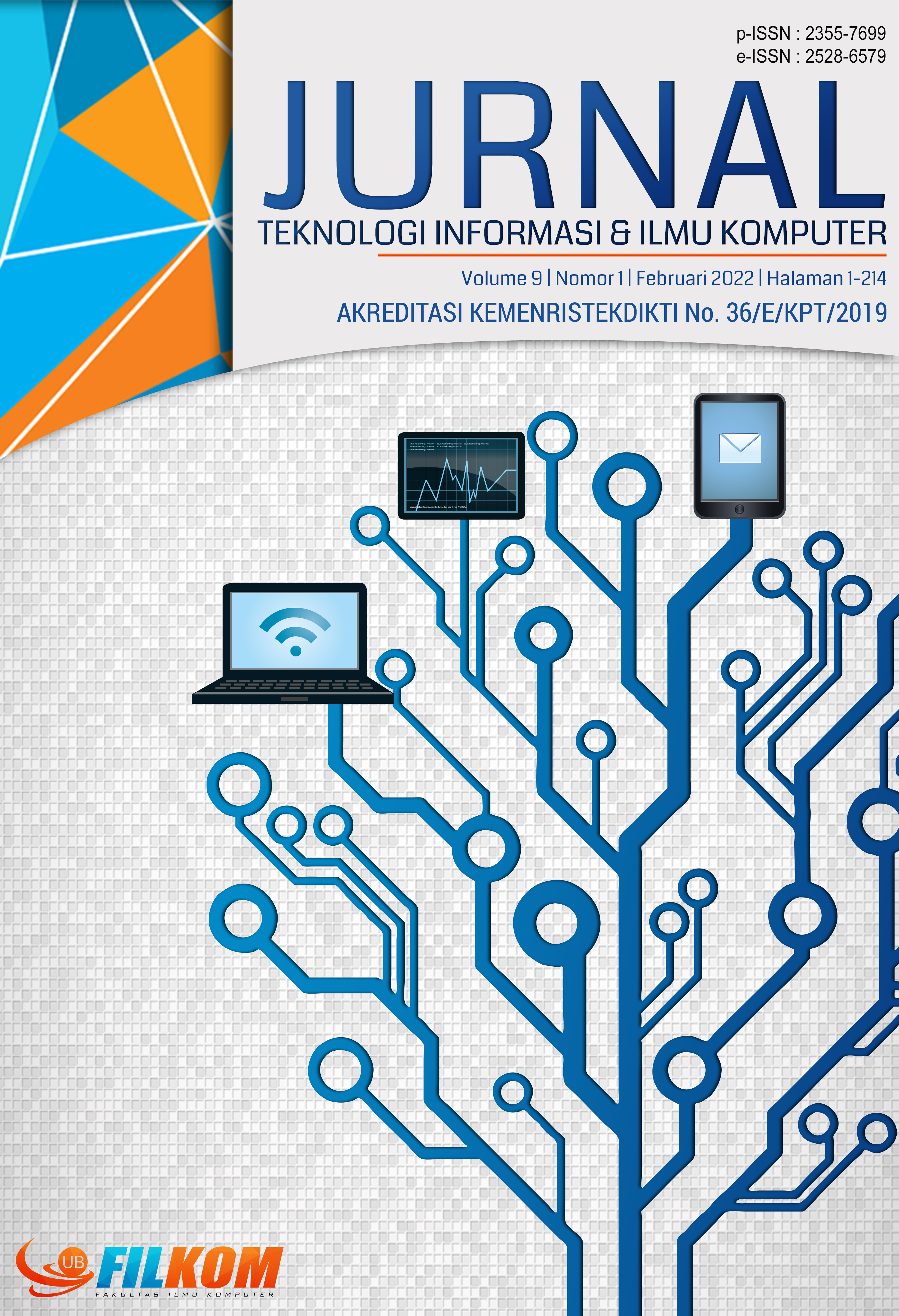Implementasi Metode Longest Common Subsequences untuk Perbaikan Kata pada Kasus Analisis Sentimen Opini Pembelajaran Daring di Media Sosial Twitter
DOI:
https://doi.org/10.25126/jtiik.2022915611Abstrak
Coronavirus merupakan salah satu parasit yang menyerang sistem pernapasan manusia. Peningkatan kasus coronavirus berlangsung sangat cepat dan menyebar ke berbagai negara. Oleh karena itu, World Health Organization (WHO) menetapkan Coronavirus sebagai pandemi. Hal ini mengakibatkan seluruh kegiatan yang sebelumnya tatap muka atau luar jaringan (luring) menjadi dalam jaringan (daring), termasuk kegiatan belajar mengajar. Dengan ditetapkannya pembelajaran secara daring menyebabkan adanya opini yang bersifat pro dan kontra dari berbagai kalangan masyarakat. Opini tersebut akan digunakan dalam penelitian ini dan akan diolah terlebih dahulu dalam tahap preprocessing. Metode yang digunakan dalam penelitian ini adalah Longest Common Subsequences (LCS) dan Support Vector Machine (SVM) dengan data sebesar 500 yang terbagi menjadi 250 data berlabel positif dan 250 data berlabel negatif. Dari 500 data tersebut dibagi menjadi 450 data untuk data latih dan 50 data untuk data uji. Dengan menggunakan metode Longest Common Subsequences untuk perbaikan kata dan metode Support Vector Machine untuk klasifikasi dengan nilai parameter terbaik yaitu learning rate (γ) = 0,0001, lambda (λ) = 0,1, complexity (C) = 0,001, epsilon (ϵ) = 0,0001 dan iterasi maksimum = 50 dapat menghasilkan nilai rata-rata hasil evaluasi yaitu precision = 0,5653, recall = 0,948, f-measure = 0,7047 dan accuracy = 0,598. Hasil pengujian tersebut mununjukkan bahwa dengan menambahkan metode Longest Common Subsequences untuk perbaikan kata dapat meningkatkan tingkat akurasi yang sebelumnya hanya 0,59 menjadi 0,598.
Abstract
Coronavirus is a parasite that attacks the human respiratory system. The increase incases coronavirus took place very fast and spread to various countries. Therefore, the World Health Organization (WHO) has designated Coronavirus as a pandemic. This results in all activities that were previously face-to-face or offline (offline) becoming online (online), including teaching and learning activities. With the establishment of online learning, there are pro and contra opinions from various circles of society. This opinion will be used in this research and will be processed first in the stage preprocessing. The method used in this research is Longest Common Subsequences (LCS) and Support Vector Machine (SVM) with 500 data divided into 250 data labeled positive and 250 data labeled negative. Of the 500 data is divided into 450 data for training data and 50 data for test data. By using the method Longest Common Subsequences for word improvement and the method Support Vector Machine for classification with the best parameter values, namely learning rate (γ) = 0.0001, lambda (λ) = 0.1, complexity (C) = 0.001, epsilon (ϵ ) = 0.0001 and the maximum iteration = 50 can produce the average value of the evaluation results, namely precision = 0.5653, recall = 0.948, f-measure = 0.7047 and accuracy = 0.598. The test results show that by adding method of Longest Common Subsequences for word improvement, it can increase the level of accuracy which was previously only 0.59 to 0.598.
Downloads
Referensi
FIRMAN & RAHMAN, S. R., 2020. Pembelajaran Online di Tengah Pandemi Covid-19. Indonesian Journal of Educational Science (IJES) , Volume 2, pp. 81-89.
HUNT, J. W. & SZYMANSKI, T. G., 1977. A Fast Algorithm for Computing Longest Common Subsequences. Journal of the ACM (JACM), Volume 20.
IVAN, SARI, Y. A. & ADIKARA, P. P., 2019. Klasifikasi Hate Speech Berbahasa Indonesia di Twitter Menggunakan Naive Bayes dan Seleksi Fitur Information Gain dengan Normalisasi Kata. Jurnal Pengembangan Teknologi Informasi dan Ilmu Komputer, Volume 3, pp. 4914-4922.
LIU, B. & ZHANG, L., 2012. A Survey of Opinion Mining and Sentiment Analysis. University of Illinois at Chicago, pp. 415-522.
ROFIQOH, U., PERDANA, S. R. & Fauzi, A. M., 2017. Analisis Sentimen Tingkat Kepuasan Pengguna Penyedia Layanan Telekomunikasi Seluler Indonesia Pada Twitter Dengan Metode Support Vector Machine dan Lexicon Based Features. Jurnal Pengembangan Teknologi Informasi dan Ilmu Komputer, Volume 1, pp. 1725-1732.
ROTHAN, H. A., N, S. & BYRAREDDY, N., 2020. The Epidemiology and Pathogenesis of Coronavirus Disease (COVID-19) Outbreak. Journal of Autoimmunity.
SANIYAH, Z., 2019. Normalisasi Mikroteks Berbentuk Singkatan pada Teks Twitter Berbahasa Indonesia Menggunakan Algoritma Longest Common Subsequences. Repositori Institusi USU .
SEMBILU, N., SAMOPA, F. & ER, M., 2018. Perbandingan Algoritma Kemiripan Teks untuk Perbaikan dan Saran Penulisan Frasa dalam Bahasa Alami. Open Access Journal Information Systems, Volume 08, pp. 19-32.
SURYANTO, A., 2015. Implementasi Metode Improved Fuzzy C-Means pada Analisis Sentimen Review Aplikasi Mobile Bahasa Indonesia.
TOSEPU, R. et al., 2020. Correlation Between Weather and Covid-19 Pandemic in Jakarta, Indonesia. Elsevier Public Health Emergency Collection.
VIJAYAKUMAR, S. & WU, S., 1999. Sequential Support Vector Classifier and Regression. Genoa, Proc. International Conference on Soft Computing (SOCO'99).
WANG, P. et al., 2017. Classification of Proactive Personality: Text Mining Based on Weibo Text and Short-answer Questions Text. IEEE Access, Volume XX.
ZHANG, Y., RUAN, X., WANG, H. & WANG, H., 2016. Twitter Trends Manipulation: A First Look Inside. IEEE Xplore, pp. 1-14.
ZHENG, W. & YE, Q., 2009. Sentiment Classification of Chinese Traveler Reviews by Support Vector Machine Algorithm. IEEE Xplore, pp. 335-338.
Unduhan
Diterbitkan
Terbitan
Bagian
Lisensi

Artikel ini berlisensi Creative Common Attribution-ShareAlike 4.0 International (CC BY-SA 4.0)
Penulis yang menerbitkan di jurnal ini menyetujui ketentuan berikut:
- Penulis menyimpan hak cipta dan memberikan jurnal hak penerbitan pertama naskah secara simultan dengan lisensi di bawah Creative Common Attribution-ShareAlike 4.0 International (CC BY-SA 4.0) yang mengizinkan orang lain untuk berbagi pekerjaan dengan sebuah pernyataan kepenulisan pekerjaan dan penerbitan awal di jurnal ini.
- Penulis bisa memasukkan ke dalam penyusunan kontraktual tambahan terpisah untuk distribusi non ekslusif versi kaya terbitan jurnal (contoh: mempostingnya ke repositori institusional atau menerbitkannya dalam sebuah buku), dengan pengakuan penerbitan awalnya di jurnal ini.
- Penulis diizinkan dan didorong untuk mem-posting karya mereka online (contoh: di repositori institusional atau di website mereka) sebelum dan selama proses penyerahan, karena dapat mengarahkan ke pertukaran produktif, seperti halnya sitiran yang lebih awal dan lebih hebat dari karya yang diterbitkan. (Lihat Efek Akses Terbuka).












